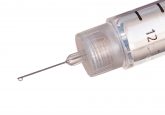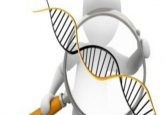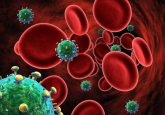DNA robots inspired by swarm behavior
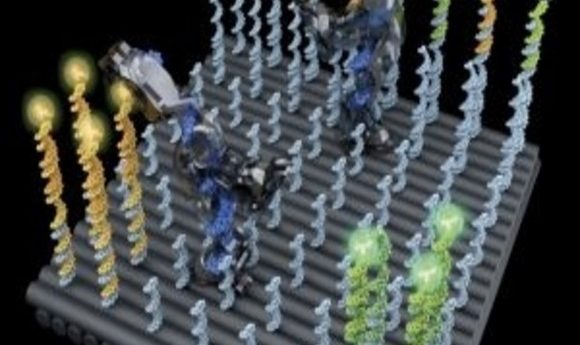
DNA robots can be programmed to explore new territories, pick up cargo, sort it into categories, and then deliver each cargo type to a defined location.
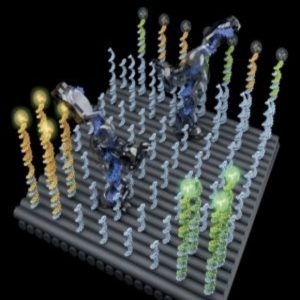
Conceptual illustration of two DNA robots (2).
Social insects carry out surprisingly complex tasks in groups, despite their limited capabilities as individuals. For example, ant colonies methodically sort their brood into a distinct pattern, placing eggs and microlarvae at the center of the cluster and arranging larger larvae in concentric rings extending toward the periphery.
This type of behavior inspires Lulu Qian from the California Institute of Technology, whose overarching research goal is to design and synthesize molecular systems with programmable behaviors. In particular, one of her goals is to develop molecular robots that can carry out complex tasks through collective behavior, similar to swarms of animals.
“Many of the molecular components in biological organisms can be viewed as machines that perform mechanical tasks at the nanometer scale,” Qian said. “Inspired by these natural molecular machines, we wanted to design and build artificial molecular machines that have similar capabilities but allow their functions to be programmed by humans.”
Toward that goal, Qian and her team recently reported an experimental molecular robotic system using multiple DNA robots to collectively perform a sophisticated nanomechanical task. Most prior studies of DNA robotics relied on individual devices, so the new study provides evidence that the powerful technique of parallelism, previously used in macro- and micro-robot systems, can be used for molecular robotics (1).
As reported in Science, the researchers developed a simple algorithm and three modular building blocks for a DNA robot that autonomously sorts cargo at the molecular level (2). The robot explored a two-dimensional testing ground on the surface of DNA origami, picked up multiple cargos of two different types that were initially at unordered locations, and delivered each type to a specified destination until all cargo molecules were sorted into two distinct piles.
“We don’t develop DNA robots for any specific applications. Our lab focuses on discovering the engineering principles that enable the development of general-purpose DNA robots,” Qian said. “However, it is my hope that other researchers could use these principles for exciting applications, such as using a DNA robot for synthesizing a therapeutic chemical from its constituent parts in an artificial molecular factory, delivering a drug only when a specific signal is given in bloodstreams or cells, or sorting molecular components in trash for recycling.”
Simple Algorithm, Modular Design
Previously, most DNA robots performed a single function: walk in a controlled direction. In some cases, the robots also picked up nanoparticles or chose a path at a junction. However, these more complex functions were also more difficult to control, and the complexity of the tasks was limited to what the robot could perform within 3–12 steps. In addition, each robot design was tailored for a specific task, complicating efforts to develop new robots that perform new tasks by combining functions and mechanisms.
“In contrast, our robot was designed to integrate multiple functions together. It walks, picks up cargo molecules, and sorts them to their specific destinations autonomously, which means no human intervention is required once the robot is in motion,” said first author Anupama Thubagere, a postdoctoral scholar in the Qian lab. “We have also shown that unique tasks can be compartmentalized on individual DNA origami, much like how biological cells function as their own compartments.”
Similar to ant-inspired sorting algorithms used in collective robotics, the researchers developed a simple algorithm for recognizing cargo and destinations. They designed the robot to perform a random walk without any energy supply. If it bumped into cargo, the robot picked it up and continued with the random walk. If it came across the specified destination of the cargo, the robot dropped it off. Then, the robot repeated the process until all cargo was sorted.
Importantly, the robot did not recognize either the type of cargo or the destination. Rather, the destination recognized matching cargo and forced the robot to drop it off. Therefore, the system can be scaled up without increasing the complexity of the robot, as long as the recognition between cargo and destination is specific.
Using DNA strand-displacement reactions, the researchers developed three modular building blocks—for the random walk, the cargo pickup, and the cargo drop-off—to implement the simple cargo-sorting algorithm. They designed a single-stranded DNA robot with one leg domain and two foot domains for walking, and one arm and one hand domain for picking up and dropping off cargo.
On average, their robot performed approximately 300 steps while sorting the cargo. The team also demonstrated two distinct cargo-sorting tasks taking place simultaneously in one test tube; multiple robots also collectively performed the same task.
“It might still be decades before DNA robots could prove themselves useful, but the more researchers working on fundamental challenges—as well as practical challenges—of molecular robotics, the sooner the day will come,” Qian said.
Moving Beyond Toys
Cargo-sorting DNA robots may one day aid in autonomous chemical synthesis, manufacturing responsive molecular devices, and producingprogrammable therapeutics. For example, in chemical synthesis, desired products can only be assembled if the chemical groups are linked together in the right order. Thus, cargo-sorting robots could work together with assembly robots to synthesize desired products from randomly distributed components. In molecular devices, cargo-sorting robots could rearrange circuit components to help the device adapt to environmental signals. Finally, microRNAs involved in disease could trigger robots to begin cargo-sorting tasks, such as gathering protein subunits together to serve as drugs.
“One could imagine some smart materials that take advantage of such sorting, for example, in the form of a molecular assembly line that shields the material against adverse environmental impact or assembles a particular drug precision-designed against an emerging biological threat,” said Nils Walter from the University of Michigan, who was not involved with the study.
However, he noted that the robot design could be improved by coupling a robot’s actions to an outside energy source, which could broaden its capabilities, or adopting a more rapid walking mechanism. The authors also have considered that they might increase the walking rate by using sequences with weaker binding energy, enzymes to drive a DNA robot, or protein motors programmed by DNA.
“Nanoscale molecular robots are becoming ever more capable,” Walter said. “As we understand better the underlying principles and incorporate more diverse design principles, the field can hopefully demonstrate one day some practically useful applications and, thus, finally convince the general audience that DNA nanorobots have moved beyond cute molecular toys.”
